Convergence Culture and Media Audience Practices
VerifiedAdded on 2023/06/08
|10
|2891
|326
AI Summary
This article explores the relevance of convergence culture to the field of media audience study, opening up new ways to see audiences as active cultural producers. The importance of introducing convergence culture with the audience of media to check how it affects their activities have been highlighted. The argument that has been questioned here is the how the introduction of new 2.0 web based technologies affect web based and non-web based audiences and whether or not it is good for the entire society as a whole.
Contribute Materials
Your contribution can guide someone’s learning journey. Share your
documents today.
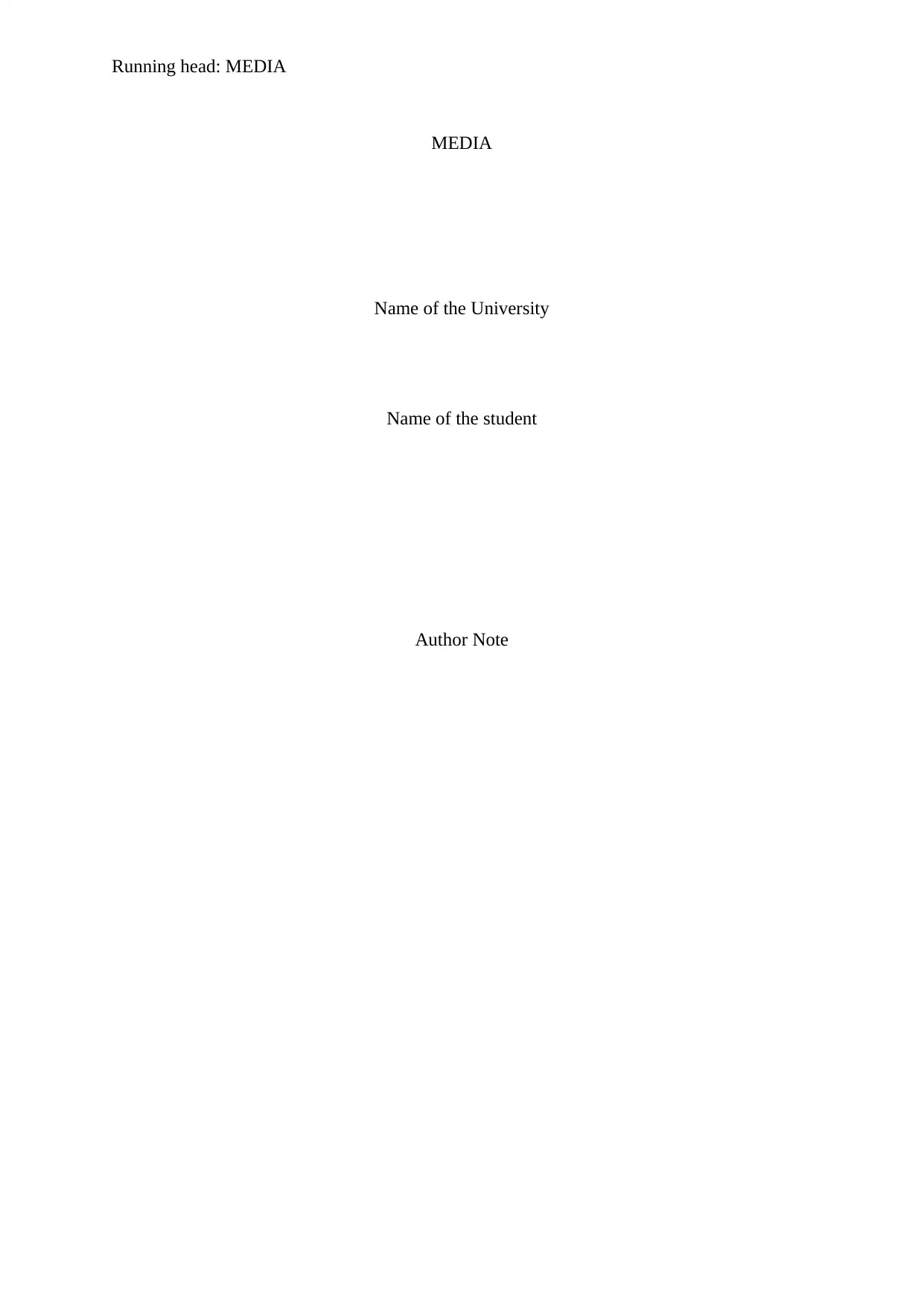
Running head: MEDIA
MEDIA
Name of the University
Name of the student
Author Note
MEDIA
Name of the University
Name of the student
Author Note
Secure Best Marks with AI Grader
Need help grading? Try our AI Grader for instant feedback on your assignments.
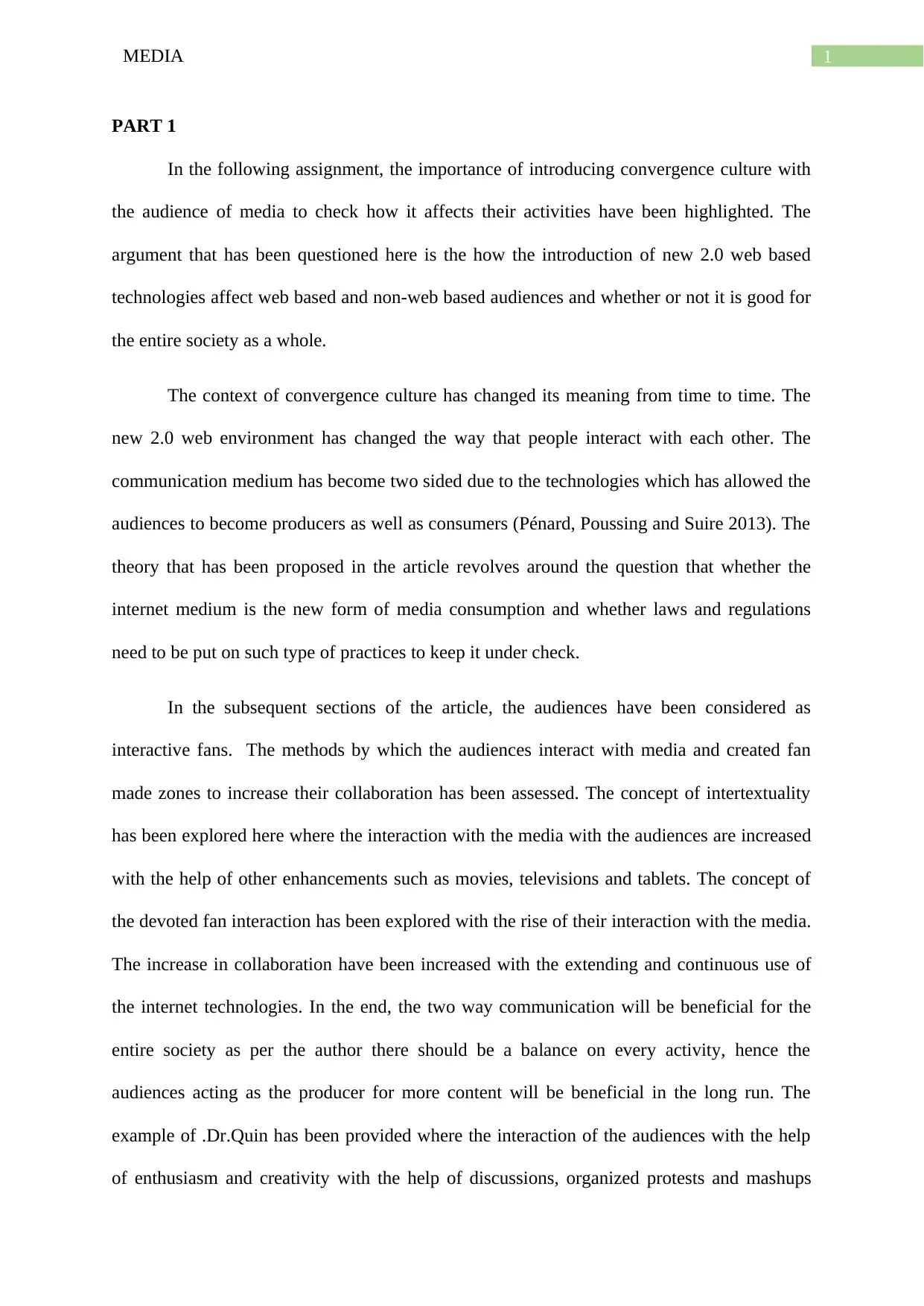
1MEDIA
PART 1
In the following assignment, the importance of introducing convergence culture with
the audience of media to check how it affects their activities have been highlighted. The
argument that has been questioned here is the how the introduction of new 2.0 web based
technologies affect web based and non-web based audiences and whether or not it is good for
the entire society as a whole.
The context of convergence culture has changed its meaning from time to time. The
new 2.0 web environment has changed the way that people interact with each other. The
communication medium has become two sided due to the technologies which has allowed the
audiences to become producers as well as consumers (Pénard, Poussing and Suire 2013). The
theory that has been proposed in the article revolves around the question that whether the
internet medium is the new form of media consumption and whether laws and regulations
need to be put on such type of practices to keep it under check.
In the subsequent sections of the article, the audiences have been considered as
interactive fans. The methods by which the audiences interact with media and created fan
made zones to increase their collaboration has been assessed. The concept of intertextuality
has been explored here where the interaction with the media with the audiences are increased
with the help of other enhancements such as movies, televisions and tablets. The concept of
the devoted fan interaction has been explored with the rise of their interaction with the media.
The increase in collaboration have been increased with the extending and continuous use of
the internet technologies. In the end, the two way communication will be beneficial for the
entire society as per the author there should be a balance on every activity, hence the
audiences acting as the producer for more content will be beneficial in the long run. The
example of .Dr.Quin has been provided where the interaction of the audiences with the help
of enthusiasm and creativity with the help of discussions, organized protests and mashups
PART 1
In the following assignment, the importance of introducing convergence culture with
the audience of media to check how it affects their activities have been highlighted. The
argument that has been questioned here is the how the introduction of new 2.0 web based
technologies affect web based and non-web based audiences and whether or not it is good for
the entire society as a whole.
The context of convergence culture has changed its meaning from time to time. The
new 2.0 web environment has changed the way that people interact with each other. The
communication medium has become two sided due to the technologies which has allowed the
audiences to become producers as well as consumers (Pénard, Poussing and Suire 2013). The
theory that has been proposed in the article revolves around the question that whether the
internet medium is the new form of media consumption and whether laws and regulations
need to be put on such type of practices to keep it under check.
In the subsequent sections of the article, the audiences have been considered as
interactive fans. The methods by which the audiences interact with media and created fan
made zones to increase their collaboration has been assessed. The concept of intertextuality
has been explored here where the interaction with the media with the audiences are increased
with the help of other enhancements such as movies, televisions and tablets. The concept of
the devoted fan interaction has been explored with the rise of their interaction with the media.
The increase in collaboration have been increased with the extending and continuous use of
the internet technologies. In the end, the two way communication will be beneficial for the
entire society as per the author there should be a balance on every activity, hence the
audiences acting as the producer for more content will be beneficial in the long run. The
example of .Dr.Quin has been provided where the interaction of the audiences with the help
of enthusiasm and creativity with the help of discussions, organized protests and mashups
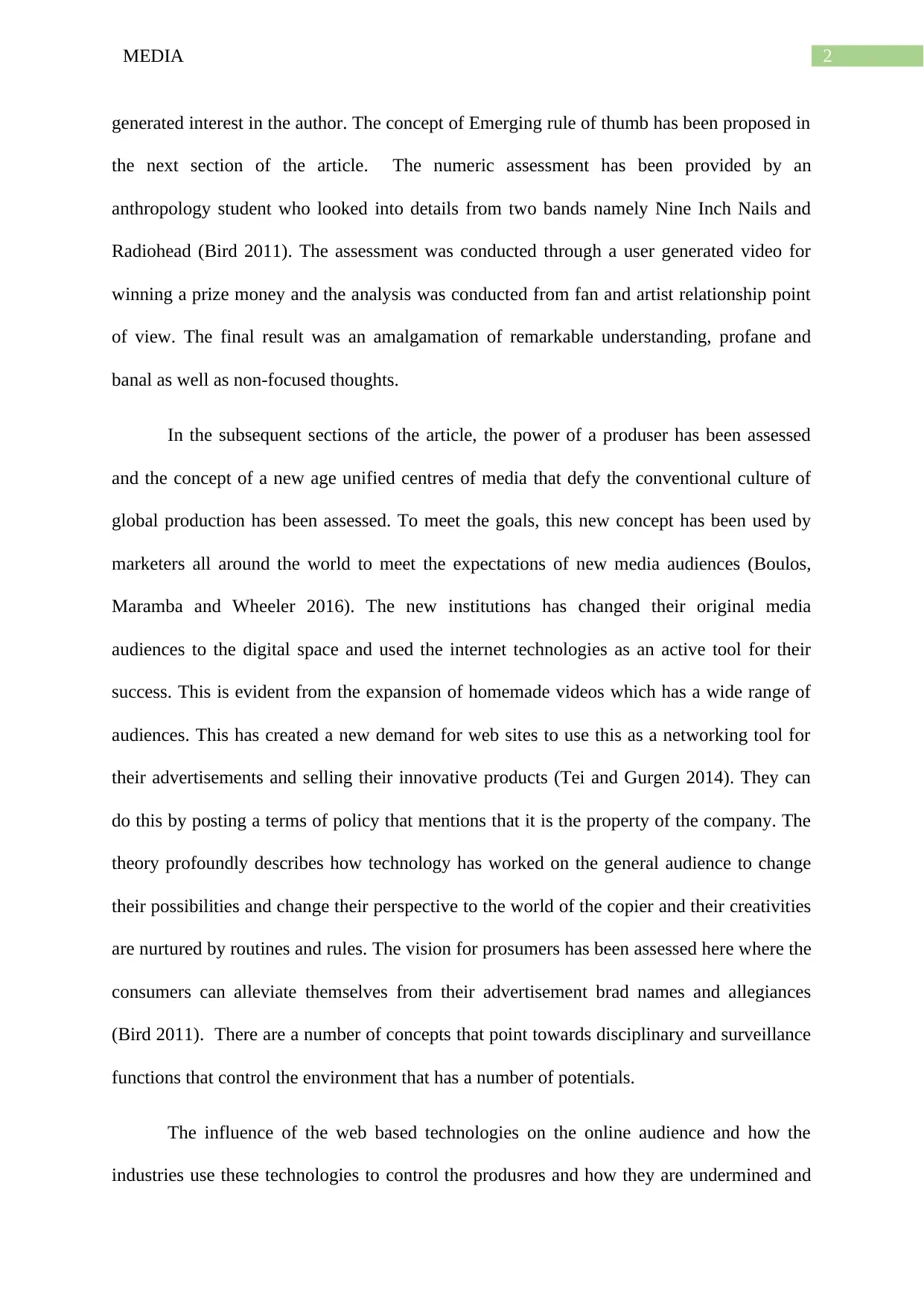
2MEDIA
generated interest in the author. The concept of Emerging rule of thumb has been proposed in
the next section of the article. The numeric assessment has been provided by an
anthropology student who looked into details from two bands namely Nine Inch Nails and
Radiohead (Bird 2011). The assessment was conducted through a user generated video for
winning a prize money and the analysis was conducted from fan and artist relationship point
of view. The final result was an amalgamation of remarkable understanding, profane and
banal as well as non-focused thoughts.
In the subsequent sections of the article, the power of a produser has been assessed
and the concept of a new age unified centres of media that defy the conventional culture of
global production has been assessed. To meet the goals, this new concept has been used by
marketers all around the world to meet the expectations of new media audiences (Boulos,
Maramba and Wheeler 2016). The new institutions has changed their original media
audiences to the digital space and used the internet technologies as an active tool for their
success. This is evident from the expansion of homemade videos which has a wide range of
audiences. This has created a new demand for web sites to use this as a networking tool for
their advertisements and selling their innovative products (Tei and Gurgen 2014). They can
do this by posting a terms of policy that mentions that it is the property of the company. The
theory profoundly describes how technology has worked on the general audience to change
their possibilities and change their perspective to the world of the copier and their creativities
are nurtured by routines and rules. The vision for prosumers has been assessed here where the
consumers can alleviate themselves from their advertisement brad names and allegiances
(Bird 2011). There are a number of concepts that point towards disciplinary and surveillance
functions that control the environment that has a number of potentials.
The influence of the web based technologies on the online audience and how the
industries use these technologies to control the produsres and how they are undermined and
generated interest in the author. The concept of Emerging rule of thumb has been proposed in
the next section of the article. The numeric assessment has been provided by an
anthropology student who looked into details from two bands namely Nine Inch Nails and
Radiohead (Bird 2011). The assessment was conducted through a user generated video for
winning a prize money and the analysis was conducted from fan and artist relationship point
of view. The final result was an amalgamation of remarkable understanding, profane and
banal as well as non-focused thoughts.
In the subsequent sections of the article, the power of a produser has been assessed
and the concept of a new age unified centres of media that defy the conventional culture of
global production has been assessed. To meet the goals, this new concept has been used by
marketers all around the world to meet the expectations of new media audiences (Boulos,
Maramba and Wheeler 2016). The new institutions has changed their original media
audiences to the digital space and used the internet technologies as an active tool for their
success. This is evident from the expansion of homemade videos which has a wide range of
audiences. This has created a new demand for web sites to use this as a networking tool for
their advertisements and selling their innovative products (Tei and Gurgen 2014). They can
do this by posting a terms of policy that mentions that it is the property of the company. The
theory profoundly describes how technology has worked on the general audience to change
their possibilities and change their perspective to the world of the copier and their creativities
are nurtured by routines and rules. The vision for prosumers has been assessed here where the
consumers can alleviate themselves from their advertisement brad names and allegiances
(Bird 2011). There are a number of concepts that point towards disciplinary and surveillance
functions that control the environment that has a number of potentials.
The influence of the web based technologies on the online audience and how the
industries use these technologies to control the produsres and how they are undermined and
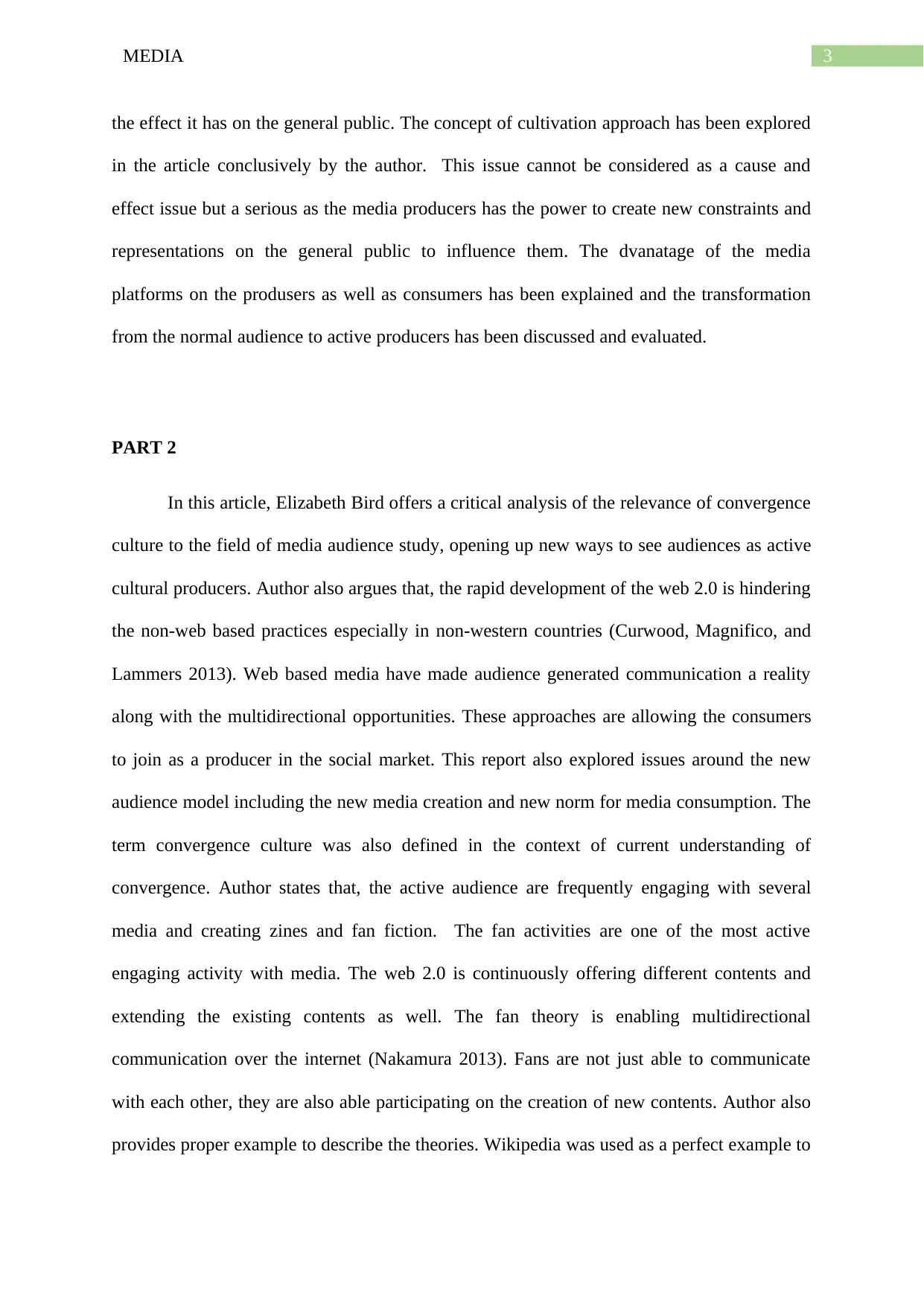
3MEDIA
the effect it has on the general public. The concept of cultivation approach has been explored
in the article conclusively by the author. This issue cannot be considered as a cause and
effect issue but a serious as the media producers has the power to create new constraints and
representations on the general public to influence them. The dvanatage of the media
platforms on the produsers as well as consumers has been explained and the transformation
from the normal audience to active producers has been discussed and evaluated.
PART 2
In this article, Elizabeth Bird offers a critical analysis of the relevance of convergence
culture to the field of media audience study, opening up new ways to see audiences as active
cultural producers. Author also argues that, the rapid development of the web 2.0 is hindering
the non-web based practices especially in non-western countries (Curwood, Magnifico, and
Lammers 2013). Web based media have made audience generated communication a reality
along with the multidirectional opportunities. These approaches are allowing the consumers
to join as a producer in the social market. This report also explored issues around the new
audience model including the new media creation and new norm for media consumption. The
term convergence culture was also defined in the context of current understanding of
convergence. Author states that, the active audience are frequently engaging with several
media and creating zines and fan fiction. The fan activities are one of the most active
engaging activity with media. The web 2.0 is continuously offering different contents and
extending the existing contents as well. The fan theory is enabling multidirectional
communication over the internet (Nakamura 2013). Fans are not just able to communicate
with each other, they are also able participating on the creation of new contents. Author also
provides proper example to describe the theories. Wikipedia was used as a perfect example to
the effect it has on the general public. The concept of cultivation approach has been explored
in the article conclusively by the author. This issue cannot be considered as a cause and
effect issue but a serious as the media producers has the power to create new constraints and
representations on the general public to influence them. The dvanatage of the media
platforms on the produsers as well as consumers has been explained and the transformation
from the normal audience to active producers has been discussed and evaluated.
PART 2
In this article, Elizabeth Bird offers a critical analysis of the relevance of convergence
culture to the field of media audience study, opening up new ways to see audiences as active
cultural producers. Author also argues that, the rapid development of the web 2.0 is hindering
the non-web based practices especially in non-western countries (Curwood, Magnifico, and
Lammers 2013). Web based media have made audience generated communication a reality
along with the multidirectional opportunities. These approaches are allowing the consumers
to join as a producer in the social market. This report also explored issues around the new
audience model including the new media creation and new norm for media consumption. The
term convergence culture was also defined in the context of current understanding of
convergence. Author states that, the active audience are frequently engaging with several
media and creating zines and fan fiction. The fan activities are one of the most active
engaging activity with media. The web 2.0 is continuously offering different contents and
extending the existing contents as well. The fan theory is enabling multidirectional
communication over the internet (Nakamura 2013). Fans are not just able to communicate
with each other, they are also able participating on the creation of new contents. Author also
provides proper example to describe the theories. Wikipedia was used as a perfect example to
Secure Best Marks with AI Grader
Need help grading? Try our AI Grader for instant feedback on your assignments.
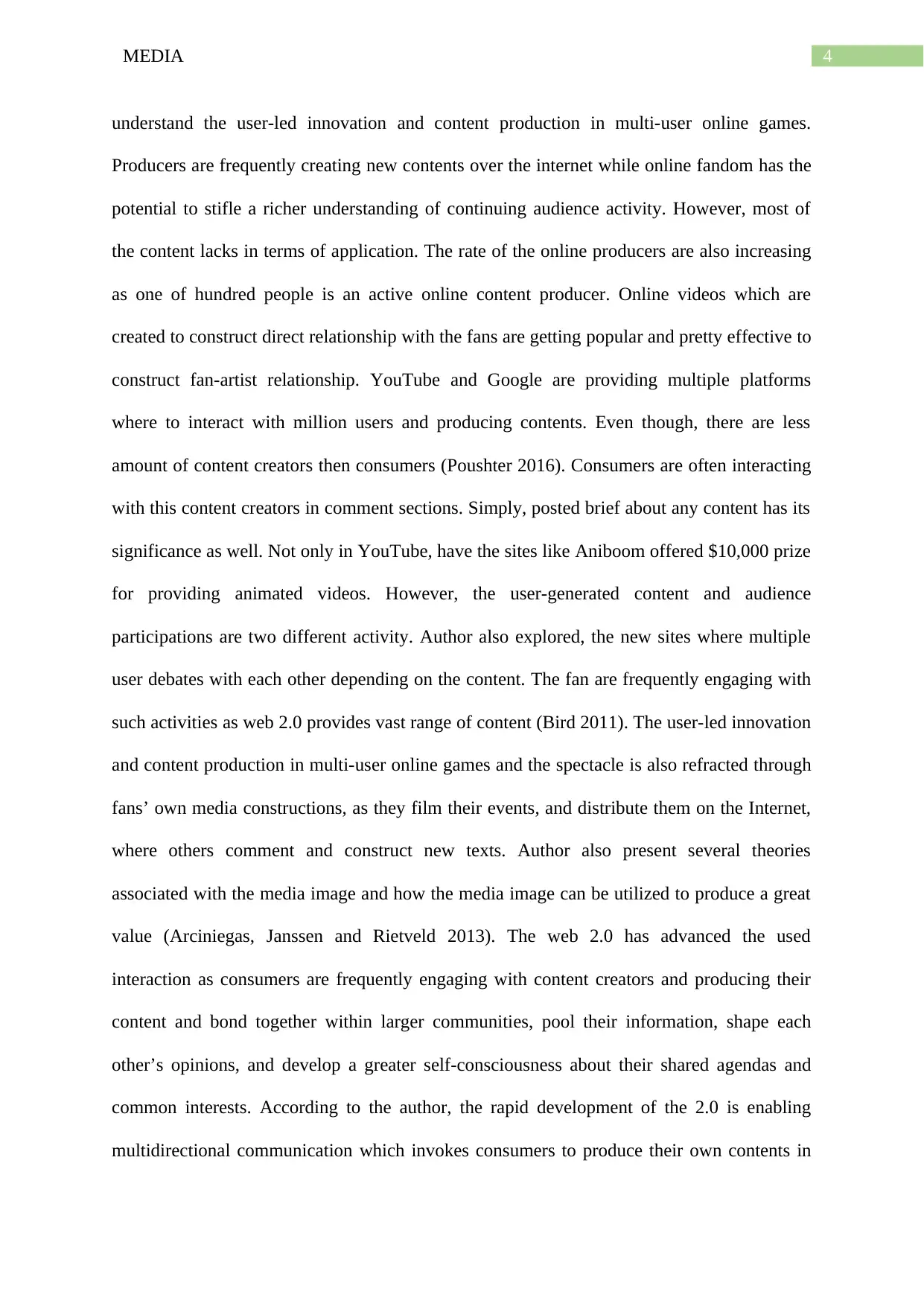
4MEDIA
understand the user-led innovation and content production in multi-user online games.
Producers are frequently creating new contents over the internet while online fandom has the
potential to stifle a richer understanding of continuing audience activity. However, most of
the content lacks in terms of application. The rate of the online producers are also increasing
as one of hundred people is an active online content producer. Online videos which are
created to construct direct relationship with the fans are getting popular and pretty effective to
construct fan-artist relationship. YouTube and Google are providing multiple platforms
where to interact with million users and producing contents. Even though, there are less
amount of content creators then consumers (Poushter 2016). Consumers are often interacting
with this content creators in comment sections. Simply, posted brief about any content has its
significance as well. Not only in YouTube, have the sites like Aniboom offered $10,000 prize
for providing animated videos. However, the user-generated content and audience
participations are two different activity. Author also explored, the new sites where multiple
user debates with each other depending on the content. The fan are frequently engaging with
such activities as web 2.0 provides vast range of content (Bird 2011). The user-led innovation
and content production in multi-user online games and the spectacle is also refracted through
fans’ own media constructions, as they film their events, and distribute them on the Internet,
where others comment and construct new texts. Author also present several theories
associated with the media image and how the media image can be utilized to produce a great
value (Arciniegas, Janssen and Rietveld 2013). The web 2.0 has advanced the used
interaction as consumers are frequently engaging with content creators and producing their
content and bond together within larger communities, pool their information, shape each
other’s opinions, and develop a greater self-consciousness about their shared agendas and
common interests. According to the author, the rapid development of the 2.0 is enabling
multidirectional communication which invokes consumers to produce their own contents in
understand the user-led innovation and content production in multi-user online games.
Producers are frequently creating new contents over the internet while online fandom has the
potential to stifle a richer understanding of continuing audience activity. However, most of
the content lacks in terms of application. The rate of the online producers are also increasing
as one of hundred people is an active online content producer. Online videos which are
created to construct direct relationship with the fans are getting popular and pretty effective to
construct fan-artist relationship. YouTube and Google are providing multiple platforms
where to interact with million users and producing contents. Even though, there are less
amount of content creators then consumers (Poushter 2016). Consumers are often interacting
with this content creators in comment sections. Simply, posted brief about any content has its
significance as well. Not only in YouTube, have the sites like Aniboom offered $10,000 prize
for providing animated videos. However, the user-generated content and audience
participations are two different activity. Author also explored, the new sites where multiple
user debates with each other depending on the content. The fan are frequently engaging with
such activities as web 2.0 provides vast range of content (Bird 2011). The user-led innovation
and content production in multi-user online games and the spectacle is also refracted through
fans’ own media constructions, as they film their events, and distribute them on the Internet,
where others comment and construct new texts. Author also present several theories
associated with the media image and how the media image can be utilized to produce a great
value (Arciniegas, Janssen and Rietveld 2013). The web 2.0 has advanced the used
interaction as consumers are frequently engaging with content creators and producing their
content and bond together within larger communities, pool their information, shape each
other’s opinions, and develop a greater self-consciousness about their shared agendas and
common interests. According to the author, the rapid development of the 2.0 is enabling
multidirectional communication which invokes consumers to produce their own contents in
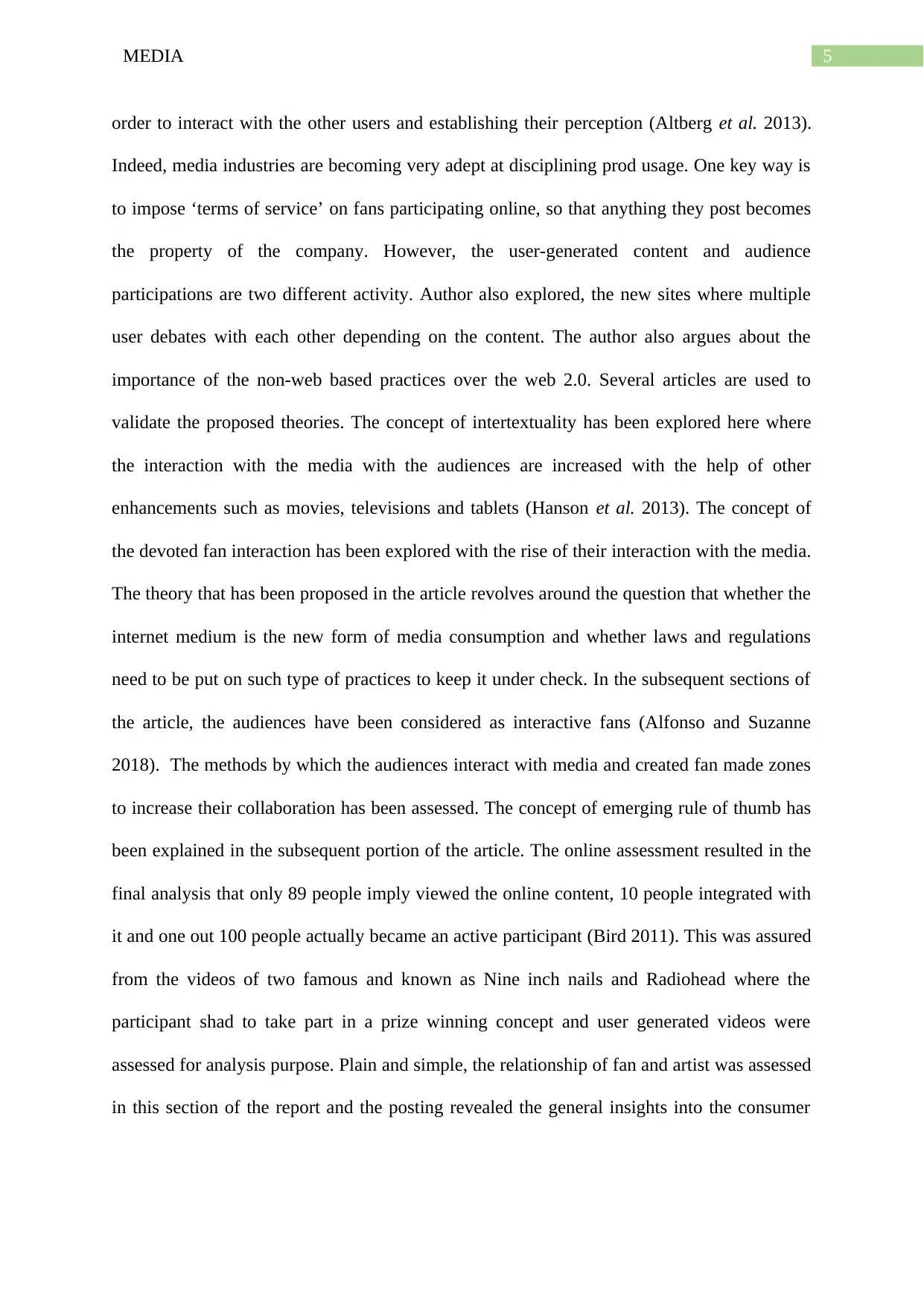
5MEDIA
order to interact with the other users and establishing their perception (Altberg et al. 2013).
Indeed, media industries are becoming very adept at disciplining prod usage. One key way is
to impose ‘terms of service’ on fans participating online, so that anything they post becomes
the property of the company. However, the user-generated content and audience
participations are two different activity. Author also explored, the new sites where multiple
user debates with each other depending on the content. The author also argues about the
importance of the non-web based practices over the web 2.0. Several articles are used to
validate the proposed theories. The concept of intertextuality has been explored here where
the interaction with the media with the audiences are increased with the help of other
enhancements such as movies, televisions and tablets (Hanson et al. 2013). The concept of
the devoted fan interaction has been explored with the rise of their interaction with the media.
The theory that has been proposed in the article revolves around the question that whether the
internet medium is the new form of media consumption and whether laws and regulations
need to be put on such type of practices to keep it under check. In the subsequent sections of
the article, the audiences have been considered as interactive fans (Alfonso and Suzanne
2018). The methods by which the audiences interact with media and created fan made zones
to increase their collaboration has been assessed. The concept of emerging rule of thumb has
been explained in the subsequent portion of the article. The online assessment resulted in the
final analysis that only 89 people imply viewed the online content, 10 people integrated with
it and one out 100 people actually became an active participant (Bird 2011). This was assured
from the videos of two famous and known as Nine inch nails and Radiohead where the
participant shad to take part in a prize winning concept and user generated videos were
assessed for analysis purpose. Plain and simple, the relationship of fan and artist was assessed
in this section of the report and the posting revealed the general insights into the consumer
order to interact with the other users and establishing their perception (Altberg et al. 2013).
Indeed, media industries are becoming very adept at disciplining prod usage. One key way is
to impose ‘terms of service’ on fans participating online, so that anything they post becomes
the property of the company. However, the user-generated content and audience
participations are two different activity. Author also explored, the new sites where multiple
user debates with each other depending on the content. The author also argues about the
importance of the non-web based practices over the web 2.0. Several articles are used to
validate the proposed theories. The concept of intertextuality has been explored here where
the interaction with the media with the audiences are increased with the help of other
enhancements such as movies, televisions and tablets (Hanson et al. 2013). The concept of
the devoted fan interaction has been explored with the rise of their interaction with the media.
The theory that has been proposed in the article revolves around the question that whether the
internet medium is the new form of media consumption and whether laws and regulations
need to be put on such type of practices to keep it under check. In the subsequent sections of
the article, the audiences have been considered as interactive fans (Alfonso and Suzanne
2018). The methods by which the audiences interact with media and created fan made zones
to increase their collaboration has been assessed. The concept of emerging rule of thumb has
been explained in the subsequent portion of the article. The online assessment resulted in the
final analysis that only 89 people imply viewed the online content, 10 people integrated with
it and one out 100 people actually became an active participant (Bird 2011). This was assured
from the videos of two famous and known as Nine inch nails and Radiohead where the
participant shad to take part in a prize winning concept and user generated videos were
assessed for analysis purpose. Plain and simple, the relationship of fan and artist was assessed
in this section of the report and the posting revealed the general insights into the consumer
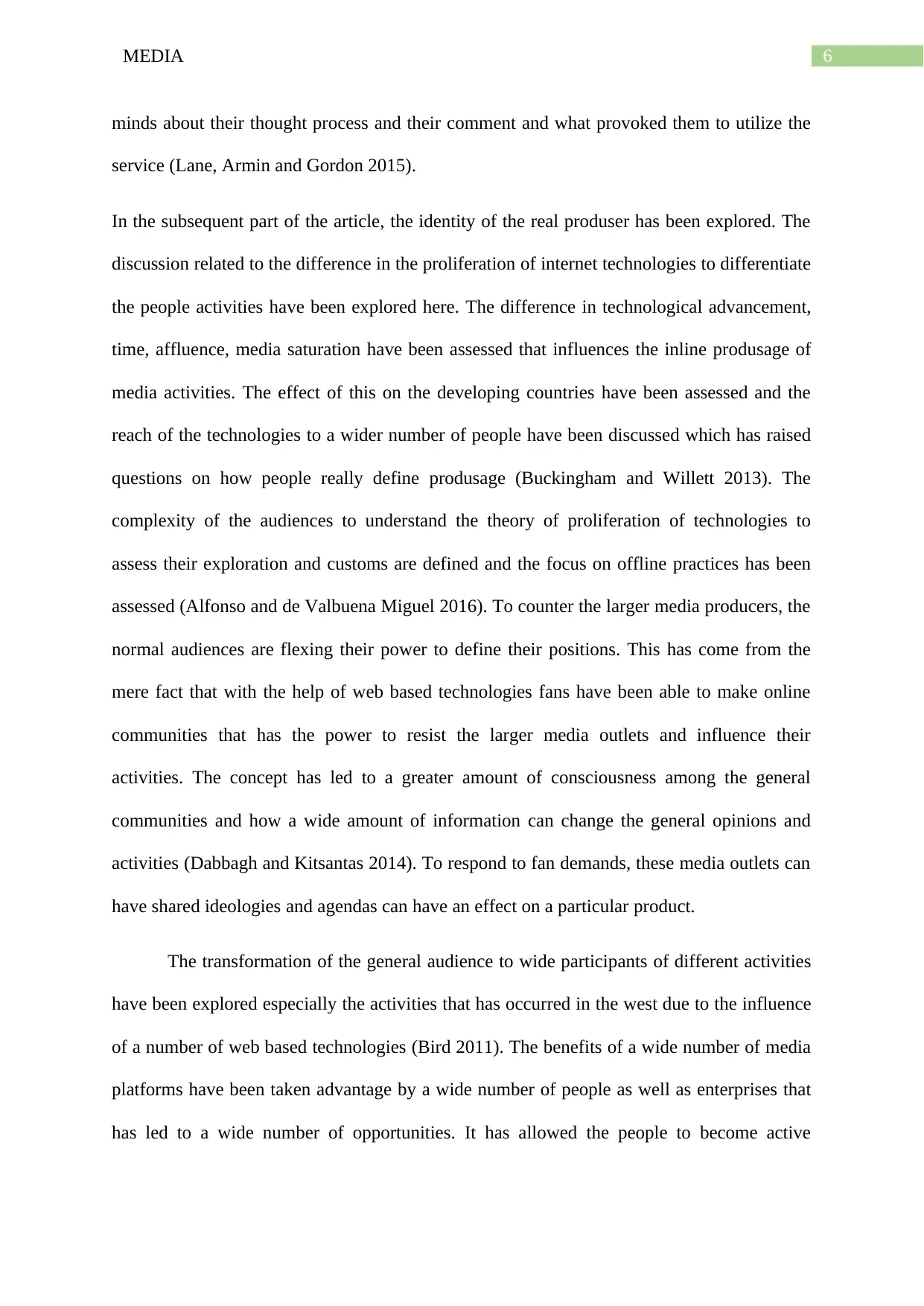
6MEDIA
minds about their thought process and their comment and what provoked them to utilize the
service (Lane, Armin and Gordon 2015).
In the subsequent part of the article, the identity of the real produser has been explored. The
discussion related to the difference in the proliferation of internet technologies to differentiate
the people activities have been explored here. The difference in technological advancement,
time, affluence, media saturation have been assessed that influences the inline produsage of
media activities. The effect of this on the developing countries have been assessed and the
reach of the technologies to a wider number of people have been discussed which has raised
questions on how people really define produsage (Buckingham and Willett 2013). The
complexity of the audiences to understand the theory of proliferation of technologies to
assess their exploration and customs are defined and the focus on offline practices has been
assessed (Alfonso and de Valbuena Miguel 2016). To counter the larger media producers, the
normal audiences are flexing their power to define their positions. This has come from the
mere fact that with the help of web based technologies fans have been able to make online
communities that has the power to resist the larger media outlets and influence their
activities. The concept has led to a greater amount of consciousness among the general
communities and how a wide amount of information can change the general opinions and
activities (Dabbagh and Kitsantas 2014). To respond to fan demands, these media outlets can
have shared ideologies and agendas can have an effect on a particular product.
The transformation of the general audience to wide participants of different activities
have been explored especially the activities that has occurred in the west due to the influence
of a number of web based technologies (Bird 2011). The benefits of a wide number of media
platforms have been taken advantage by a wide number of people as well as enterprises that
has led to a wide number of opportunities. It has allowed the people to become active
minds about their thought process and their comment and what provoked them to utilize the
service (Lane, Armin and Gordon 2015).
In the subsequent part of the article, the identity of the real produser has been explored. The
discussion related to the difference in the proliferation of internet technologies to differentiate
the people activities have been explored here. The difference in technological advancement,
time, affluence, media saturation have been assessed that influences the inline produsage of
media activities. The effect of this on the developing countries have been assessed and the
reach of the technologies to a wider number of people have been discussed which has raised
questions on how people really define produsage (Buckingham and Willett 2013). The
complexity of the audiences to understand the theory of proliferation of technologies to
assess their exploration and customs are defined and the focus on offline practices has been
assessed (Alfonso and de Valbuena Miguel 2016). To counter the larger media producers, the
normal audiences are flexing their power to define their positions. This has come from the
mere fact that with the help of web based technologies fans have been able to make online
communities that has the power to resist the larger media outlets and influence their
activities. The concept has led to a greater amount of consciousness among the general
communities and how a wide amount of information can change the general opinions and
activities (Dabbagh and Kitsantas 2014). To respond to fan demands, these media outlets can
have shared ideologies and agendas can have an effect on a particular product.
The transformation of the general audience to wide participants of different activities
have been explored especially the activities that has occurred in the west due to the influence
of a number of web based technologies (Bird 2011). The benefits of a wide number of media
platforms have been taken advantage by a wide number of people as well as enterprises that
has led to a wide number of opportunities. It has allowed the people to become active
Paraphrase This Document
Need a fresh take? Get an instant paraphrase of this document with our AI Paraphraser

7MEDIA
participants in a democracy from the general audience due to the two easy communication
system that has been discussed.
participants in a democracy from the general audience due to the two easy communication
system that has been discussed.
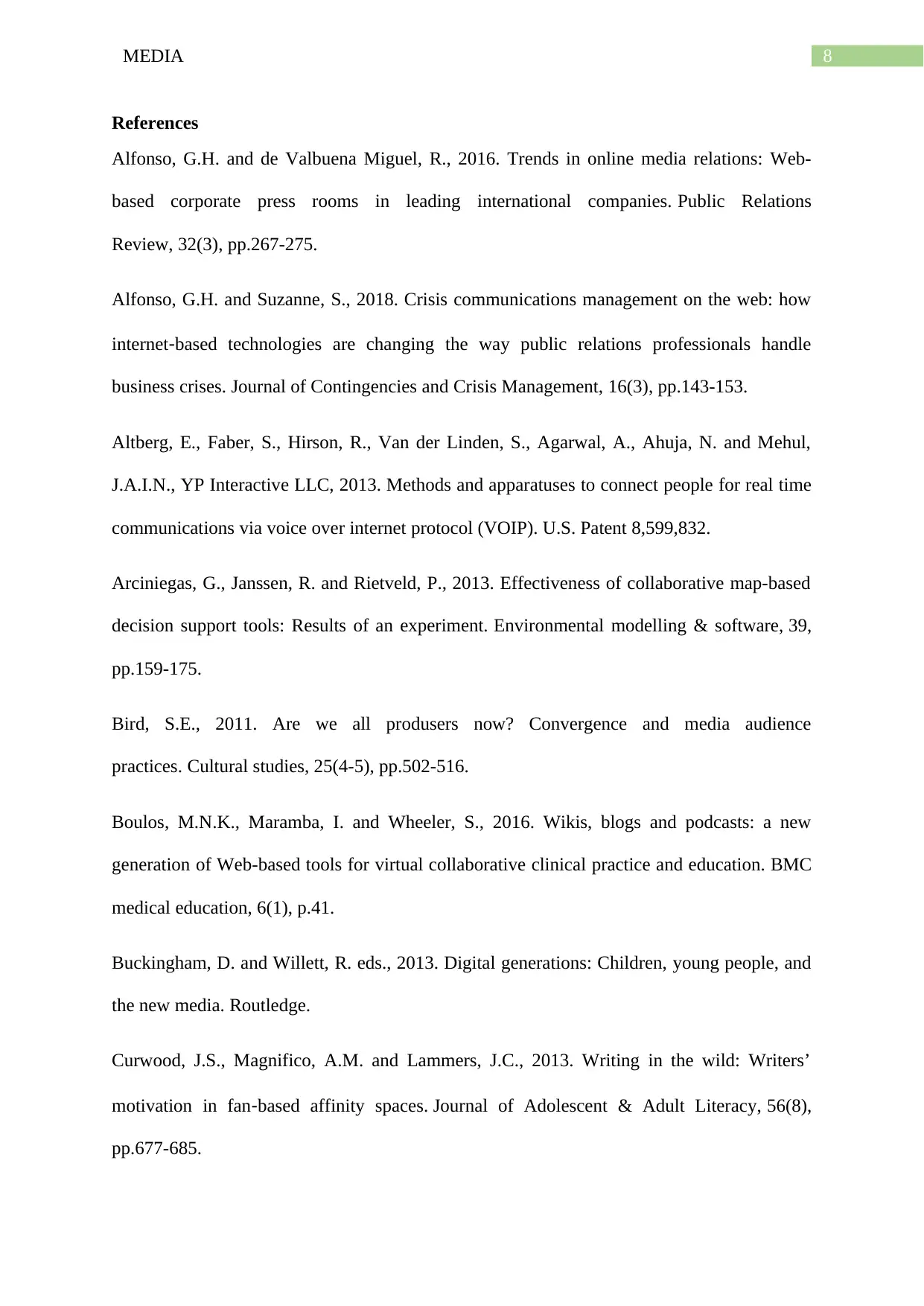
8MEDIA
References
Alfonso, G.H. and de Valbuena Miguel, R., 2016. Trends in online media relations: Web-
based corporate press rooms in leading international companies. Public Relations
Review, 32(3), pp.267-275.
Alfonso, G.H. and Suzanne, S., 2018. Crisis communications management on the web: how
internet‐based technologies are changing the way public relations professionals handle
business crises. Journal of Contingencies and Crisis Management, 16(3), pp.143-153.
Altberg, E., Faber, S., Hirson, R., Van der Linden, S., Agarwal, A., Ahuja, N. and Mehul,
J.A.I.N., YP Interactive LLC, 2013. Methods and apparatuses to connect people for real time
communications via voice over internet protocol (VOIP). U.S. Patent 8,599,832.
Arciniegas, G., Janssen, R. and Rietveld, P., 2013. Effectiveness of collaborative map-based
decision support tools: Results of an experiment. Environmental modelling & software, 39,
pp.159-175.
Bird, S.E., 2011. Are we all produsers now? Convergence and media audience
practices. Cultural studies, 25(4-5), pp.502-516.
Boulos, M.N.K., Maramba, I. and Wheeler, S., 2016. Wikis, blogs and podcasts: a new
generation of Web-based tools for virtual collaborative clinical practice and education. BMC
medical education, 6(1), p.41.
Buckingham, D. and Willett, R. eds., 2013. Digital generations: Children, young people, and
the new media. Routledge.
Curwood, J.S., Magnifico, A.M. and Lammers, J.C., 2013. Writing in the wild: Writers’
motivation in fan‐based affinity spaces. Journal of Adolescent & Adult Literacy, 56(8),
pp.677-685.
References
Alfonso, G.H. and de Valbuena Miguel, R., 2016. Trends in online media relations: Web-
based corporate press rooms in leading international companies. Public Relations
Review, 32(3), pp.267-275.
Alfonso, G.H. and Suzanne, S., 2018. Crisis communications management on the web: how
internet‐based technologies are changing the way public relations professionals handle
business crises. Journal of Contingencies and Crisis Management, 16(3), pp.143-153.
Altberg, E., Faber, S., Hirson, R., Van der Linden, S., Agarwal, A., Ahuja, N. and Mehul,
J.A.I.N., YP Interactive LLC, 2013. Methods and apparatuses to connect people for real time
communications via voice over internet protocol (VOIP). U.S. Patent 8,599,832.
Arciniegas, G., Janssen, R. and Rietveld, P., 2013. Effectiveness of collaborative map-based
decision support tools: Results of an experiment. Environmental modelling & software, 39,
pp.159-175.
Bird, S.E., 2011. Are we all produsers now? Convergence and media audience
practices. Cultural studies, 25(4-5), pp.502-516.
Boulos, M.N.K., Maramba, I. and Wheeler, S., 2016. Wikis, blogs and podcasts: a new
generation of Web-based tools for virtual collaborative clinical practice and education. BMC
medical education, 6(1), p.41.
Buckingham, D. and Willett, R. eds., 2013. Digital generations: Children, young people, and
the new media. Routledge.
Curwood, J.S., Magnifico, A.M. and Lammers, J.C., 2013. Writing in the wild: Writers’
motivation in fan‐based affinity spaces. Journal of Adolescent & Adult Literacy, 56(8),
pp.677-685.
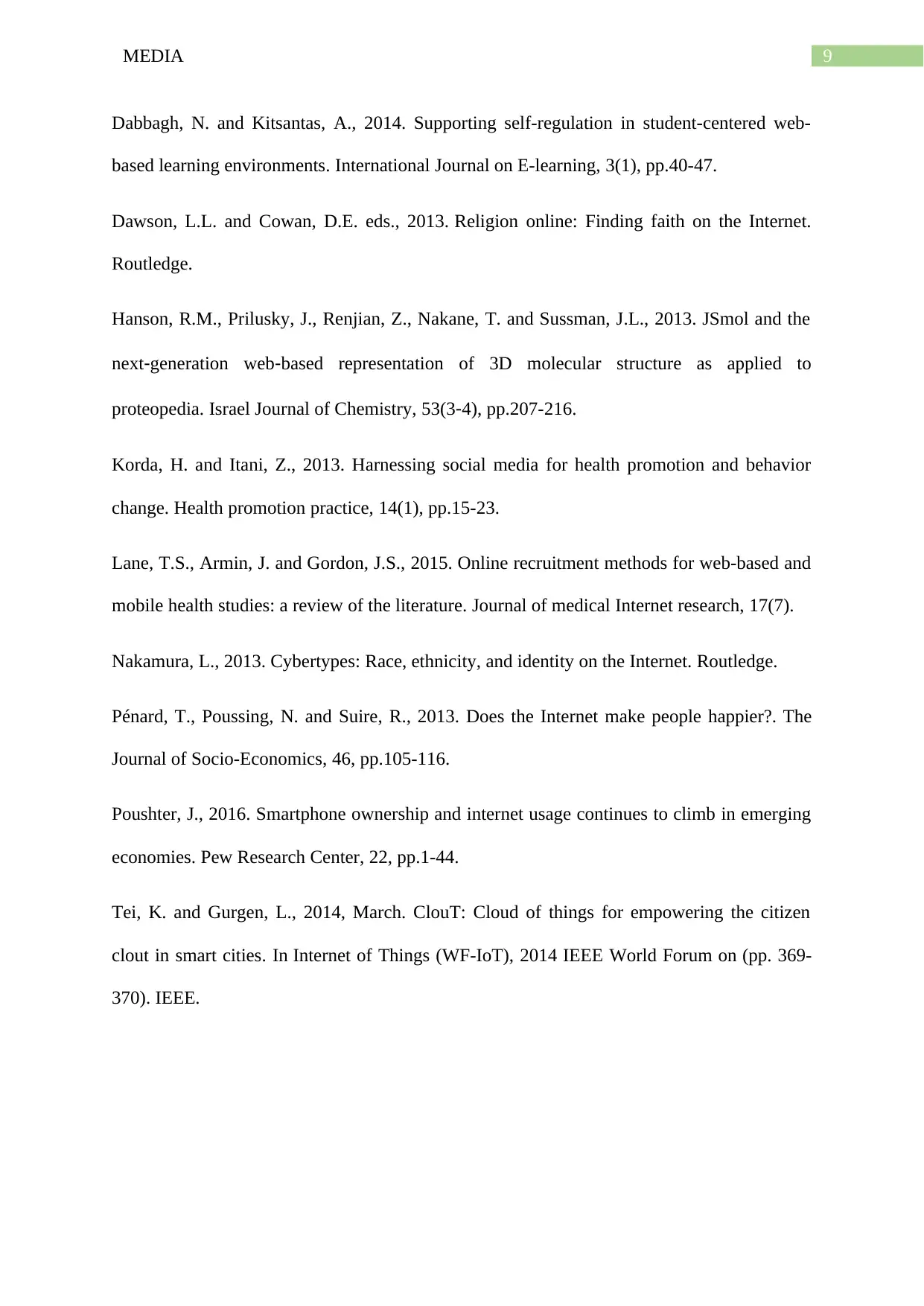
9MEDIA
Dabbagh, N. and Kitsantas, A., 2014. Supporting self-regulation in student-centered web-
based learning environments. International Journal on E-learning, 3(1), pp.40-47.
Dawson, L.L. and Cowan, D.E. eds., 2013. Religion online: Finding faith on the Internet.
Routledge.
Hanson, R.M., Prilusky, J., Renjian, Z., Nakane, T. and Sussman, J.L., 2013. JSmol and the
next‐generation web‐based representation of 3D molecular structure as applied to
proteopedia. Israel Journal of Chemistry, 53(3‐4), pp.207-216.
Korda, H. and Itani, Z., 2013. Harnessing social media for health promotion and behavior
change. Health promotion practice, 14(1), pp.15-23.
Lane, T.S., Armin, J. and Gordon, J.S., 2015. Online recruitment methods for web-based and
mobile health studies: a review of the literature. Journal of medical Internet research, 17(7).
Nakamura, L., 2013. Cybertypes: Race, ethnicity, and identity on the Internet. Routledge.
Pénard, T., Poussing, N. and Suire, R., 2013. Does the Internet make people happier?. The
Journal of Socio-Economics, 46, pp.105-116.
Poushter, J., 2016. Smartphone ownership and internet usage continues to climb in emerging
economies. Pew Research Center, 22, pp.1-44.
Tei, K. and Gurgen, L., 2014, March. ClouT: Cloud of things for empowering the citizen
clout in smart cities. In Internet of Things (WF-IoT), 2014 IEEE World Forum on (pp. 369-
370). IEEE.
Dabbagh, N. and Kitsantas, A., 2014. Supporting self-regulation in student-centered web-
based learning environments. International Journal on E-learning, 3(1), pp.40-47.
Dawson, L.L. and Cowan, D.E. eds., 2013. Religion online: Finding faith on the Internet.
Routledge.
Hanson, R.M., Prilusky, J., Renjian, Z., Nakane, T. and Sussman, J.L., 2013. JSmol and the
next‐generation web‐based representation of 3D molecular structure as applied to
proteopedia. Israel Journal of Chemistry, 53(3‐4), pp.207-216.
Korda, H. and Itani, Z., 2013. Harnessing social media for health promotion and behavior
change. Health promotion practice, 14(1), pp.15-23.
Lane, T.S., Armin, J. and Gordon, J.S., 2015. Online recruitment methods for web-based and
mobile health studies: a review of the literature. Journal of medical Internet research, 17(7).
Nakamura, L., 2013. Cybertypes: Race, ethnicity, and identity on the Internet. Routledge.
Pénard, T., Poussing, N. and Suire, R., 2013. Does the Internet make people happier?. The
Journal of Socio-Economics, 46, pp.105-116.
Poushter, J., 2016. Smartphone ownership and internet usage continues to climb in emerging
economies. Pew Research Center, 22, pp.1-44.
Tei, K. and Gurgen, L., 2014, March. ClouT: Cloud of things for empowering the citizen
clout in smart cities. In Internet of Things (WF-IoT), 2014 IEEE World Forum on (pp. 369-
370). IEEE.
1 out of 10
Related Documents
Your All-in-One AI-Powered Toolkit for Academic Success.
+13062052269
info@desklib.com
Available 24*7 on WhatsApp / Email
![[object Object]](/_next/static/media/star-bottom.7253800d.svg)
Unlock your academic potential
© 2024 | Zucol Services PVT LTD | All rights reserved.





